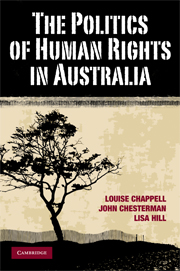Book contents
- Frontmatter
- Contents
- Acknowledgements
- List of abbreviations
- Introduction
- 1 Human Rights
- 2 Protecting Human Rights
- 3 A Bill of Rights?
- 4 Electoral Rights in Australia
- 5 The Rights of Indigenous Australians
- 6 Gender and Sexuality Rights
- 7 Refugees
- 8 Civil and Political Rights in an Age of Terror
- Notes
- Index
- References
2 - Protecting Human Rights
- Frontmatter
- Contents
- Acknowledgements
- List of abbreviations
- Introduction
- 1 Human Rights
- 2 Protecting Human Rights
- 3 A Bill of Rights?
- 4 Electoral Rights in Australia
- 5 The Rights of Indigenous Australians
- 6 Gender and Sexuality Rights
- 7 Refugees
- 8 Civil and Political Rights in an Age of Terror
- Notes
- Index
- References
Summary
Without a bill of rights, Australians are required to look to other institutions for their human rights protection. The Constitution, parliament and the courts each play a role in this process. The Constitution includes some limited rights provisions, the legislature has passed laws to protect rights in certain areas and the courts have upheld some rights under the common law. However, the idea advanced at the time of federation that these institutions would combine to provide an adequate safeguard against the infringement of human rights by government is now seriously under question. The limitations that exist within and among these institutional arenas mean that they provide, at best, a patchy net of protection through which many minorities slip. Australia's existing human rights framework has not come to terms with important developments of the past 50 years: changing community expectations about the importance of human rights, the dominance of the executive over parliament and the rise of larger and more powerful government. Attempts by each institution, especially the High Court, to interpret the Constitution and the common law to reflect these changes, has led to controversy and conflict between the different branches of Australian government. The effort to bring the international human rights regime to bear in national human rights debates has further complicated the scene and resulted in rights seekers becoming even more confused about where to look for protection.
- Type
- Chapter
- Information
- The Politics of Human Rights in Australia , pp. 27 - 61Publisher: Cambridge University PressPrint publication year: 2009



